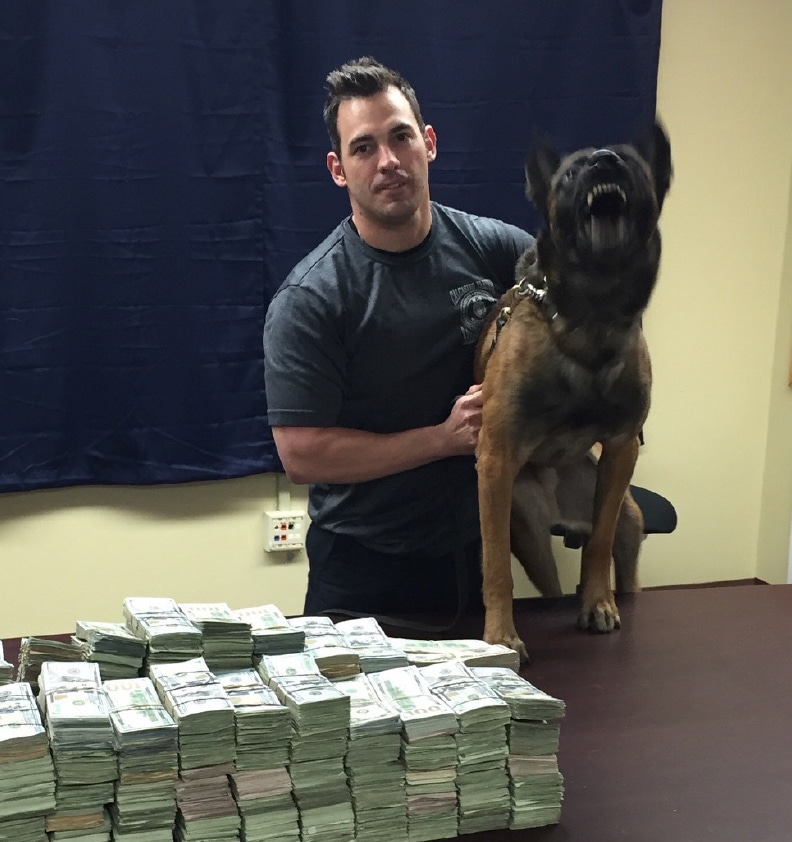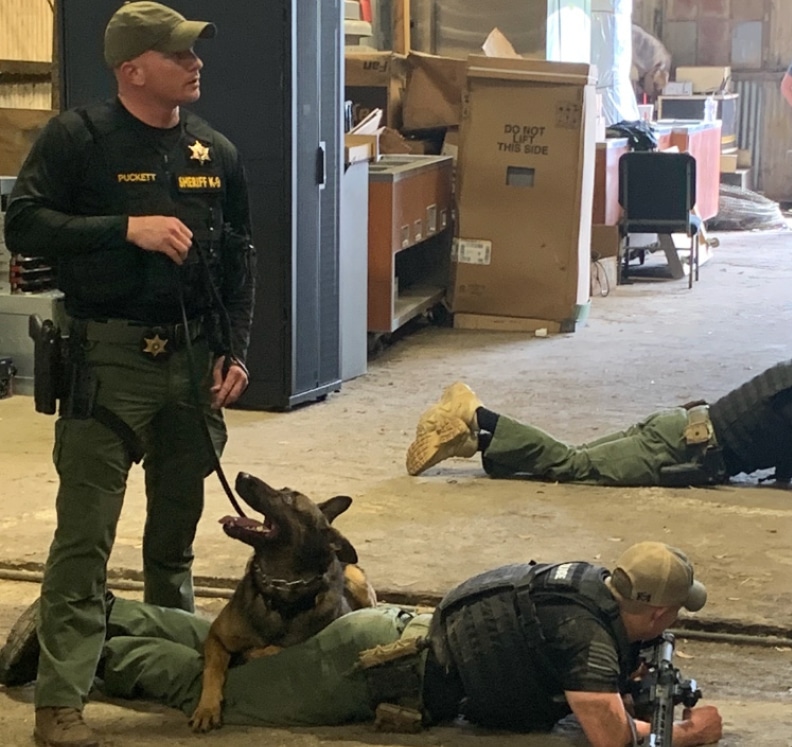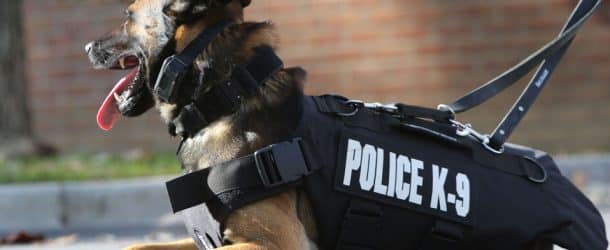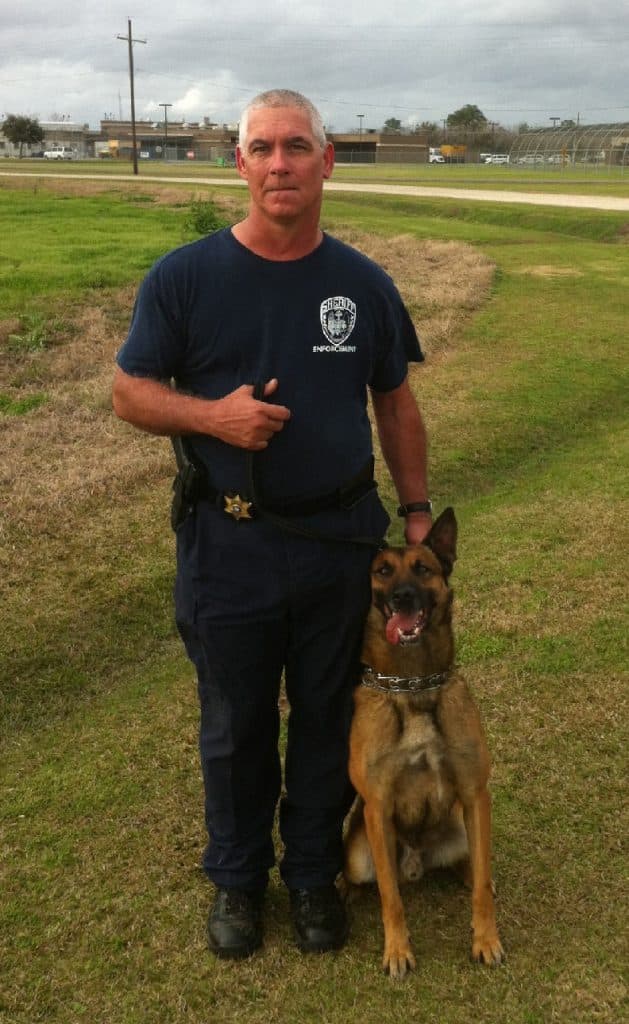A Look At Local Law Enforcement K-9 Units
By Karla Wall
The recent death of King, the K-9 partner of Cpl. Chris Duhon of the Calcasieu Parish Sheriff’s Office, has focused the spotlight on local K-9 units, the loyalty and dedication of the four-legged officers that help their human counterparts in so many ways, and on the bond that forms between K-9s and their handlers.
The Lake Charles Police Dept. has five K-9 teams on staff: three dual-purpose teams and two interdiction units. The Sheriff’s Office has 13 units: six patrol units, four interdiction units, 1 SWAT unit, 1 corrections unit and an explosives unit.
K-9 Duties
Law enforcement K-9s serve in many capacities. Interdiction teams, says CPSO Sgt. Bradley Guidry, are tasked with helping officers find and confiscate drugs and drug money being transported along the interstate.
Patrol dogs are trained in sniffing out narcotics, locating suspects and apprehending a suspect who is fighting. They also search for narcotics in schools. They assist in burglary and robbery calls and fights involving large crowds.
A SWAT K-9 is used in difficult arrests, hostage situations and any other situation which requires a response by a SWAT team.
“The SWAT team decides on a situational basis whether or not to deploy the K-9,” says Guidry. “They may be sent in to search for humans, or find and hold someone hiding in a building.”
Explosives K-9s are trained to detect bombs and other incendiary devices.
K-9s also serve in tracking, search and rescue, street patrol and in many other capacities.
What Makes A K-9?
Dogs chosen for K-9 duty are purchased from and trained by a skilled K-9 trainer. The CPSO gets its dogs from US K9 Unlimited near Abbeville; the LCPD has dogs trained at K-9 Concepts in Broussard, La.
The dogs are trained at the facility for about three months. That initial training is followed by daily or weekly training with the dog’s partner.
But not just any dog can be considered for training.
First, not all breeds of dogs have the physical characteristics and the mentality to serve as a K-9. Both the LCPD and the CPSO use Belgian Malinois, or a closely related breed, such as the Dutch Shepherd. Both breeds are similar in appearance to a German Shepherd.
Jack Robicheaux of K-9 Concepts says he gets almost all of his dogs from Europe. He’s made many trips overseas to evaluate and purchase dogs, both as “orders” from law enforcement departments or simply to train and keep at his facility so that he “always has a few dogs” to provide local law enforcement.
How tough is it for a young dog to make the roster? On a recent trip overseas, Robicheaux ended up bringing back only 11.
What qualities does he look for in a future K-9?

“If they’re any younger than that, they’re too immature to handle police work,” he says.
Guidry says that, to him, temperament is the first and foremost quality he looks for in a K-9.
“You want the dog to be social, but you want him to ‘turn on’ when it’s time to work,” he says. “I also look for a dog that is confident in every discipline he’s been trained for. “
Robicheaux says that a stable and social temperament is the first thing he looks for. “They have to be social. They have to like people,” he says. They also, he says, have to be able to remain stable around gunfire, and while climbing and walking on unusual surfaces.
And part of being comfortable doing all of that is being physically up to the challenge. K-9s not only have to climb, crawl and run, but they also have to lie still, possibly for quite some time, which can be uncomfortable if hips and elbows aren’t healthy.
“They have to have hips x-rayed and be certified free of dysplasia,” Robicheaux says. “The elbows also have to be x-rayed and cleared. They have to be physically able to do the work.”
Robicheaux says the dogs he evaluates have gone through the Royal Dutch Police training program, where they’re trained in Schutzhund (obstacle course work and bite work), agility and obedience.
The desire to work and to see a job through is also important, says Guidry.
“One of the things we do to test is throw a ball into some tall grass, without letting the dog see it, and send the dog out to find it. You’re looking to see how long the dog will look for it. You want a dog that will search for that ball until it’s found. Some will search for a bit and then give up. You want them to go beyond just a cursory look.”
The Training Never Stops
Once a dog is trained and paired with a handler, the two train together at the training facility — three weeks at K-9 Concepts, and five weeks at K9 Unlimited.
“The handlers will learn how to work their dog in narcotics searches, suspect searches, tracking through wooded timber and other areas,” says Guidry.

At both the LCPD and the CPSO, the team then goes on the road to work. The new CPSO teams ride with K-9 Sgt. Nathan McKee for two to three weeks before going out on their own.
But training is an ongoing process, and handlers are constantly training their dogs. The teams work weekly in scenario-based exercises.
“At the CPSO, these weekly training exercises are used to solve any issues the handlers are having with their dogs.
And, says Guidry, handlers are constantly working their dogs at home.
“Any time they do anything with the dog, they are giving it commands — bathing it, feeding it, throwing a ball and playing with it — they’re always working with the dog,” he says.
According to a statement from the LCPD, “Even off duty, handlers do individual training. It is sometimes said that a handler spends more time with their K-9 than they do with their families.”
A Part Of The Family
While both the LCPD and CPSO say that K-9s are classified as tools to be used by the departments, they are far more than that to their handlers. They become the handlers’ protectors and often their best friends.
K-9s live with their handlers and their families. The LCPD provides kennels with a deck and a roof, screens and fans to be used in the summer months, and a doghouse with straw for use in the winter.
But many handlers choose to have their dogs live inside with them.
“Off duty, a K-9 is able to relax and be a dog living at home with the family,” says Guidry.

















Comments are closed.